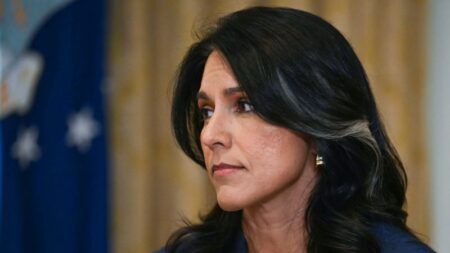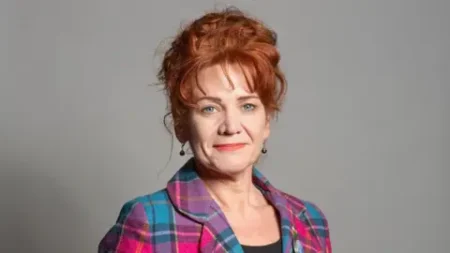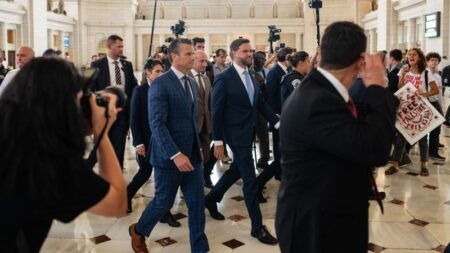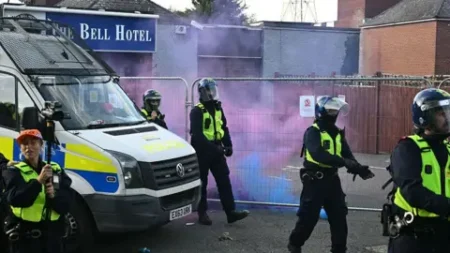The recent influx of federal law enforcement officers and National Guard troops in Washington, D.C., reflects President Donald Trump’s ongoing crackdown on crime in the nation’s capital. As tensions rise surrounding public safety, President Trump and his allies have increasingly criticized the city’s juvenile crime laws. This scrutiny has intensified following a violent incident involving a 19-year-old former DOGE staffer who was assaulted by a group of teenagers, which Trump attributed to the failure of decades of Democratic leadership in D.C.
As statistics reveal, youth arrests surged to a post-pandemic high in 2023, indicating a concerning trend in juvenile crime rates. The D.C. Metropolitan Police reported that during the first half of 2025, the number of juveniles arrested was the highest it had been since 2019. This alarming data has prompted Trump to urge legislative changes, asserting that the law must enable the prosecution of violent juvenile offenders as adults, particularly those as young as 14. In a statement on Truth Social, he emphasized that young offenders are aware they may be released shortly after committing violent acts, indicating a perceived failure in the current system.
The conflict between Trump and U.S. Attorney for the District of Columbia, Jeanine Pirro, focuses on the inadequacies of D.C.’s juvenile justice system. Pirro has publicly criticized existing laws, arguing that they fail to adequately hold young offenders accountable for their crimes. Presently, D.C. laws largely prevent offenders younger than 15 from being prosecuted as adults, although there are pathways for some 16 and 17-year-olds to be tried in the adult justice system, particularly for severe crimes such as murder and armed robbery.
This situation is compounded by a long-standing rift between the U.S. Attorney’s Office and the D.C. Attorney General’s Office, which typically handles juvenile offenses. The latter is committed to prosecuting serious juvenile crimes, maintaining that they pursue all violent offenses where evidence supports prosecution. Nonetheless, Pirro and Trump argue that changes are necessary to remedy what they perceive as a lenient approach to juvenile crime enforcement.
In her recent statements, Pirro has identified specific laws she wishes to amend or abolish. One such example is the 2018 Youth Rehabilitation Act, which aims to separate younger offenders from older, more experienced criminals. This act has been criticized for its perceived leniency, particularly in cases involving violent crimes leading to light sentences, such as probation for a 19-year-old who shot a fellow Metrobus passenger.
Additionally, she targeted the 2021 Incarceration Reduction Amendment Act, which allows offenders up to age 25 to petition for sentence reductions after serving a minimum of 15 years in prison. Pirro argues that the act, which requires consideration of various factors before a sentence modification, is insufficient to address the seriousness of juvenile crime.
Echoing her sentiments, she stated unequivocally, “I know evil when I see it, no matter the age,” reinforcing her stance that the current system fails to provide the necessary consequences for violent juvenile offenders. She believes that treating violent youth offenders with leniency undermines justice for victims and their families.
On the other hand, critics, including criminal justice experts and local officials, assert that the approach championed by Trump and Pirro is outdated, reminiscent of the tough-on-crime rhetoric from the 1990s. They argue that more contemporary strategies are needed, strategies that reflect a deeper understanding of adolescent development and the efficacy of rehabilitation. Eduardo Ferrer, for instance, emphasizes that the D.C. Attorney General’s office is more grounded in research, focusing on rehabilitation rather than solely punitive measures.
Councilmember Christina Henderson further reinforced this perspective, asserting that many believe in a balanced approach to youth justice that avoids the extremes of strict punishment or indiscriminate leniency. She highlighted the importance of local governance in juvenile crime legislation, asserting that D.C. should be allowed to make choices reflective of its community’s needs, particularly since these laws pertain to its youth.
In conclusion, the debate over how to handle juvenile crime in Washington, D.C., is indicative of deeper ideological divides about justice and rehabilitation. As local leaders and federal officials grapple with this complex matter, the future response to juvenile crime in the capital remains highly contested and pivotal.











